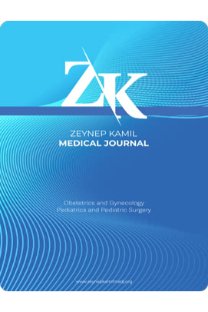Premenstrual Sendromlu Kadınlarda Uyku Hijyen Girişimlerinin Etkisi
Premenstrual Sendrom, Uyku Hijyen Girişimleri, Uyku Hijyen Eğitimi
The Effect of a Sleep Hygiene Interventions in Women with Premenstrual Syndrome
Premenstrual syndrome sleep hygiene intervention, sleep hygiene education, Pittsburgh Sleep Quality Index,
___
- 1. American Psychiatric Association, a Diagnostic and Statistical Manual of Mental Disorders. 4th Ed. Text revision. Washington, DC: American Psychiatric Association. 2000; 771-774. https://www.psychiatry.org/ Accessed 26 March 2016.
- 2. Freeman EW. Premenstrual syndrome and premenstrual dysphoric disorder: definitions and diagnosis. Psychoneuro endocrinology 2003; 28: 25-37.
- 3. Angst J, Sellaro R, Merikangas KR. Endicott J. The epidemiology of perimenstrual psychological symptoms. Acta Psychiatrica Scandinavica 2001; 104 (2): 110-116.
- 4. Steiner M, Peer M, Palova E, Freeman EW, Macdougall M, Soares CN. The Premenstrual Symptoms Screening Tool revised for adolescents (PSST-A): prevalence of severe PMS and premenstrual dysphoric disorder in adolescents. Archives of Women's Mental Health. 2011; 14 (1): 77-81.
- 5. Nisar N, Zehra N, Haider G, Munir AA, Sohoo NA, Frequency, intensity and impact of premenstrual syndrome in medical participants. J Coll Physicians Surg Pak 2008; 18(8): 481-4.
- 6. Guvenç G, Kilic A, Akyuz A, Ustunsoz A. Premenstrual syndrome and attitudes toward menstruation in a sample of nursing participants. Journal of Psychosomatic Obstetrics & Gynecology 2012; 33 (3): 106-111.
- 7. Delara, F, Ghofranipour P, Azadfallah, SS, Tavafian A, Kazemnejad A, Montazeri. Health related quality of life among adolescents with premenstrual disorders: a cross sectional study. Health Qual Life Outcomes 2012; 10 (1).
- 8. Gürkan ÖC, Türk S. Experience and Coping with Premenstrual Syndrome of Participants at University. Health and Society 2008; 18 (2): 17-23 . 9. Reid RL, Premenstrual Syndrome. in: Gibbs RS, Karlan BY, Haney AF, Nygaard IE (Eds), Danforth's Obstetrics and Gynecology, Lippincott Williams & Wilkins, Philadelphia, 2008.
- 10. Karaman HIO, Tanriverdi G, Degirmenci Y. Subjective sleep quality in premenstrual syndrome. Gynecological Endocrinology 2012; 28 (8): 661 - 664.
- 11. National Sleep Foundation. Sleep in America poll 2007. Conference held March 5–6, 2007, Washington, DC. http://sleepfoundation.org (accessed 15.06.2015).
- 12. Baker FC, Lamarche LJ, Iacovides S, Colrain IM. Sleep and menstrual-related disorder. Sleep Medicine Clinics 2008; 3(1): 25-35.
- 13. Lamarche LJ, Driver HS, Wiebe S, Crawford L, De Koninck J. Nocturnal sleep, daytime sleepiness, and napping among women with significant emotional/behavioral premenstrual symptoms. Journal of Sleep Research 2007; 16 (3): 262-268.
- 14. Manber R, Bootzin RR. Sleep and the menstrual cycle. Health Psychology1997; 16 (3): 209-14.
- 15. Hauri P, Current Concepts: The Sleep Disorders. The Upjohn Company, Kalamazoo, Michigan.1997.
- 16. Friedman L, Benson K, Noda A, Zarcone V, Wicks D, et al. An actigraphic comparison of sleep restriction and sleep hygiene treatments for insomnia in older adults. Journal of Geriatric Psychiatry and Neurology 2000; 13(1): 17-27.
- 17. Chen PH, Kuo HY, Chueh KH. Sleep hygiene education: efficacy on sleep quality in working women. Journal of Nursing Research 2000; 18 (4): 283-289.
- 18. Mastin DF, Bryson J, Corwyn R. Assessment of sleep hygiene using the Sleep Hygiene Index. Journal of Behavioral Medicine 2006; 29 (3): 223-227.
- 19. Stepanski EJ, Wyatt JK. Use of sleep hygiene in the treatment of insomnia. Sleep Medicine Reviews 2003; 7(3): 215-225.
- 20. Gençdoğan B. A New Scale for Premenstrual Syndrome. Psychiatry in Turkey 2006; 8 (2): 83–87.
- 21. Buysse DJ, Reynolds CF, Monk TH, Berman SR, Kupfer DJ. The Pittsburgh Sleep Quality Index: a new instrument for psychiatric practice and research. Psychiatry Research 1989; 28 (2): 193-213.
- 22. Ağargün MY, Kara H, Anlar OA. Validity and reliability of Pittsburgh Sleep Quality Index. Turk Psychiatry Journal 1996; 7 (2): 107-115.
- 23. Blunden SL, Chapman J, Rigney GA. Are sleep education programs successful? The case for improved and consistent research efforts, Sleep Medicine Reviews 2012; 16(4): 355-370.
- 24. Daley A. Exercise and premenstrual symptomatology: a comprehensive review. J Women’s Health (Larchmt) 2009; 8 (6): 895-899.
- 25. Salamat S, Ismail KM, O’Brien S. Premenstrual syndrome. Obstetrics, Gynecology & Reproductive Medicine 2008; 18 (2): 29-32.
- ISSN: 1300-7971
- Yayın Aralığı: 4
- Başlangıç: 1969
- Yayıncı: Ali Cangül
Çocukluk Çağı Tümörlerinin Akciğer Metastazlarına Cerrahi Yaklaşım
RAHŞAN ÖZCAN, Ayşe KARAGÖZ, Ebru GÖKDEMİR, PINAR KENDİGELEN, Tiraje CELKAN, İBRAHİM ADALETLİ, Osman F. ŞENYÜZ, Gonca T. TEKANT
Premenstrual Sendromlu Kadınlarda Uyku Hijyen Girişimlerinin Etkisi
Özlem C. GÜRKAN, Süreyya T. ÖĞÜN, Dilek C. POTUR, NURAN KÖMÜRCÜ
Datura Stramonium Zehirlenmesi Sonucu Antikolinerjik Sendrom: İki Olgu Sunumu
Aysin NALBANTOĞLU, Mustafa Törehan ASLAN, Nedim SAMANCI, Dilek Yaman TAŞ
VULVADA PARAÜRETRAL EKSTRAGASTROİNTESTİNAL STROMAL TÜMÖR; OLGU SUNUMU
Mesut TEK, İdris AYDIN, Yasemin YUYUCU KARABULUT, Mürşide ÇEVİKOĞLU KILLI
Gebelik ve tropikal parazitik enfeksiyonlar
K. Emre KARAŞAHİN, MUSTAFA ÖZTÜRK, İBRAHİM ALANBAY, Fahri Burçin FIRATLIGİL
NEKROTİK TORSİYONE PARATUBAL KİST İLE BERABER INTAKT FALLOP TÜP TORSİYONU: OLGU SUNUMU
MEHMET AKİF SARGIN, Murat YASSA, Mehmet TURUNÇ, Emrah ORHAN, Niyazi TUĞ
Vulvada Paraüretral Ekstra Gastrointestinal Stromal Tümör: Olgu Sunumu
Mesut TEK, İdris AYDIN, Yasemin Yuyucu KARABULUT, Mürşide Çevikoğlu KILLI
Gebelıkte Olağan Fızıksel Yakınmalar
FATMA COŞAR ÇETİN, NURDAN DEMİRCİ, KIYMET YEŞİLÇİÇEK ÇALIK, AYŞE ÇİL AKINCI
GEBELİKTE OLAĞAN FİZİKSEL YAKINMALAR
Fatma Coşar Çetin, Nurdan Demirci, Kıymet Yeşilçiçek Çalık, Ayşe Çil Akıncı
